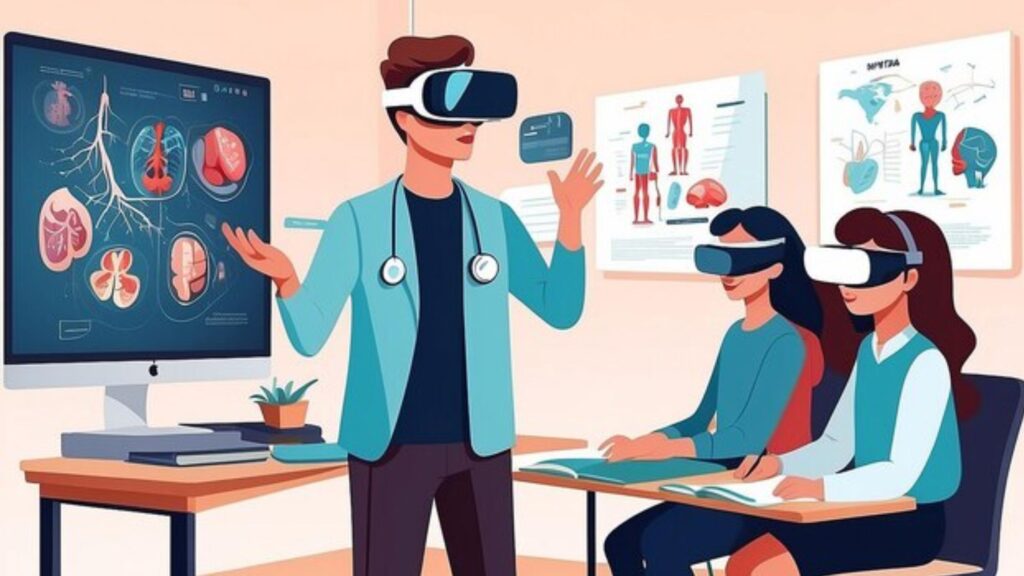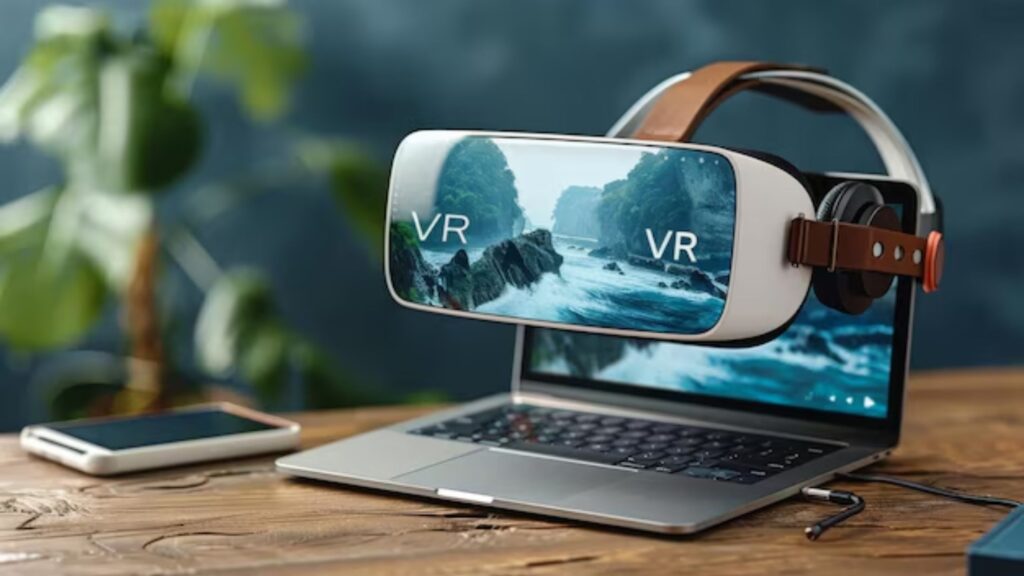Starting a virtual reality therapy business offers a unique opportunity to enter the digital health sector with low initial costs. The main idea is to develop VR programs that can be used for therapy, rehabilitation or mental health treatment. Using existing VR technology and inexpensive development tools, you can develop customized programs for different therapeutic needs. This approach allows you to take advantage of current technology without heavy investment, making it an accessible way to enter the healthcare industry.

Table of Contents
To successfully set up your Virtual Reality Therapy Business, you will need a clear understanding of VR technology and its use in therapy. Do research to select cost-efficient development tools and platforms that match your therapy focus. Decide which particular therapy area you want to focus on, whether it is mental health, physical rehabilitation or other therapeutic applications. With these fundamental elements, you can effectively start your Virtual Reality Therapy Business and make a positive contribution to the digital health sector.
1. Skill Development for Virtual Reality Therapy Business
Getting the skills required for Virtual Reality Therapy Business development is crucial to the success of your Virtual Reality Therapy Business. If you are a techie, you will need specialized skills and knowledge to get involved in the VR content creation process. This includes the use of VR software, 3D modeling, animation, and interactive design. You can take help of online courses, workshops, and tutorials to learn these skills.

If you lack the time or expertise for VR content development, hiring a professional developer or team can be a good option. For this, you can search on freelance platforms like Upwork or Freelancer, or contact a VR agency. An experienced team or developer can create custom VR programs according to your needs and provide you support from a technical perspective.
After hiring or skill development, you should regularly stay updated about new technologies and trends. VR technology is constantly changing, so keeping track of the latest technological advancements is essential to maintaining the quality of your program. Additionally, you’ll need to pay attention to feedback and user experience so you can improve the effectiveness and usability of your program over time.
2. Tool Selection: Choose Affordable VR Development Tools and Platforms
Choosing the right tools and platforms for Virtual Reality Therapy Business development is essential to the success of your Virtual Reality Therapy Business. There are many VR development tools available, some of which are free or inexpensive, while others can be expensive. To minimize the initial investment, focus on tools that are affordable but can meet your development needs. Some popular and affordable options include Unity and Unreal Engine, which offer extensive resources and community support.

Unity is a versatile VR development platform suitable for both beginners and professional developers. Its free version is available and it includes many inexpensive plug-ins and tools that can simplify your programming and design process. Similarly, Unreal Engine is also a powerful and affordable option, providing high-quality graphics and real-time rendering capabilities. Its inexpensive licenses and available resources will help make your VR project run smoothly.
When selecting a platform, also keep in mind that the tools you choose also meet your long-term development and maintenance needs. When using cheap or free tools, make sure they align with your project goals and that you can easily update and improve them in the future. With the proper tool selection, you can develop your VR content with high quality and effectiveness, while keeping the initial investment under control.
3. Prototype Creation: Develop a Basic VR Therapy Program Prototype
To create an effective Virtual Reality Therapy Business, it is important to first create a basic prototype. The purpose of a prototype is to turn your ideas and concepts into reality so that you can see how your VR program will work. It includes the initial design, interactive elements, and user interface. A simple and functional prototype helps you get initial user feedback and know how effective your concept is.
When creating a prototype, keep in mind that it is a test version and its priority is only the basics of functionality and design. You should focus on the main functionalities that are the key features of your program without going into too much detail. An initial prototype can help you make sure that your concept is going in the right direction and identify the necessary improvements. Experimentation and exploration are important in this stage, so that you can improve your prototype.
After creating the prototype, it is necessary to test it with potential users and get their feedback. User feedback will help you understand the effectiveness and usability of your prototype, and help you identify areas of improvement. Based on the information gained from this process, you can improve your prototype and make the necessary changes for the final program. An effective and user-sensitive prototype will play a vital role in the success of your Virtual Reality Therapy Business.
4. Testing and Feedback: Test the prototype with target users and get feedback
Testing the prototype with target users is important, as it gives you insight into the actual user experience and effectiveness. During testing, your prototype is applied to different users so you can see how they interact and identify their problems or difficulties. This process ensures that the features and functionalities of your Virtual Reality Therapy Business are meeting the user’s needs and they are able to use it comfortably.
Getting feedback is an important part of this phase. During testing, get detailed feedback from users, including their experiences, problems, and suggestions. This feedback will highlight the strengths and weaknesses of your prototype and guide you towards improvements. Analyze the feedback carefully and consider it a valuable resource for improvement, allowing you to improve various aspects of the prototype.
After the process of testing and feedback of the prototype, it is important to implement the necessary improvements and changes. This ensures that your final VR therapy program is tailored to the needs and expectations of users. Making improvements based on testing and feedback will make your program more effective and user-sensitive, which will ultimately contribute to the success of your Virtual Reality Therapy Business.
5. Launch Your VR Therapy Program and Promote it to Healthcare Providers and Patients
To launch your VR therapy program, you must first prepare a solid launch plan. This plan should clearly define your program’s features, benefits, and target users. On the day of the launch, present your program on various channels, such as the website, social media, and other digital platforms. An effective launch event or webinar can also be organized, where you can showcase your program’s features and attract potential customers.

The marketing strategy involves targeting healthcare providers and patients. To let healthcare providers know about the benefits of your program and how to use it, you can organize specially designed marketing materials, presentations, and medicine conferences. This will encourage them to understand the value of your program and incorporate it into their treatment protocols. Additionally, you can promote the program by partnering with healthcare professionals or through their recommendations.
To attract patients, you need to create clear and effective marketing materials that explain your program’s benefits and how to use it in simple language. Use social media, blogs, and online advertisements to promote your program to a wide audience. Also, share positive user stories and case studies that highlight the program’s effectiveness. With consistent marketing efforts, you can increase the visibility and acceptance of your VR therapy program, allowing more people to reap its benefits.
6. Continuous Improvement: Update and Improve Your Program Regularly
Continuous improvement is extremely important for a successful Virtual Reality Therapy Business. This process ensures that your program stays up to date over time and adapts to the changing needs of users and technological advancements. Regular updates and improvements maintain the quality of your program, improve user experience, and keep up with new medical research and techniques. For this, you need to pay attention to user feedback, the latest technological trends, and changes in the medical field.

To update the program, you need to implement new features, corrective patches, and technical updates. Identify improvements based on user experience and ensure that any bugs or issues in the program are fixed. Additionally, improve the program based on new medical research or new technologies, so that it remains in line with the latest standards in the healthcare field. Continuous improvement will increase your program’s effectiveness and user satisfaction.
In the process of updating and improving, testing the program regularly is also essential. This ensures that all new features and improvements are working correctly and are not negatively affecting the user experience. Through constant monitoring and testing, you can quickly identify and resolve issues, improving the quality and reliability of your program. Thus, with constant improvement, you can keep your Virtual Reality Therapy Business excellent and successful in the long run.
7. Estimated investment: ₹50,000 to ₹70,000
The estimated investment for starting a Virtual Reality Therapy Business can range from ₹50,000 to ₹70,000, depending on various factors. First, there will be the cost of development tools and software. By using free or inexpensive development platforms like Unity or Unreal Engine, you can reduce your initial costs, but if you need more specialized tools, they may cost extra. Also, if you hire professional developers or designers, their fees will also be included in your budget.

In the second step, there is the cost of software licenses and appropriate hardware. To develop VR content, you will need high-quality software and VR headsets. If you buy or lease these devices, it will affect your total cost. Considering this expense, it is important that you manage your budget in a balanced manner, so that enough money is allocated for all the necessary resources.
Finally, initial marketing efforts will also require investment. To launch and promote your program, you will have to spend on advertising, social media campaigns, and other marketing activities. These expenses can affect your budget, but with the right marketing strategy, you can increase the visibility and acceptance of your program. Overall, with the right planning and management, you can develop and launch an effective Virtual Reality Therapy Business with an investment of ₹50,000 to ₹70,000.
8. How much profit can be made in this Virtual Reality Therapy Business
The amount of profit in a Virtual Reality Therapy Business depends on various factors, such as the quality of the program, marketing strategy, and target customer segment. Compared to the initial investment, a successful program can generate high returns, especially if you promote your program effectively among healthcare providers and patients. With a high-quality program and the right targeted marketing, you can increase the chances of good profits. Through the sale and licensing of the program, you can generate a steady income.

The amount of profit also depends on how many customers or users you can attract to your program. If you partner with healthcare providers and encourage them to use your program, you can get massive sales. Also, if the success and effectiveness of your program is proven, there may be good demand from patients as well. Thus, you have to take into account your customer base and the acceptability of the program while calculating the profit.
Once your program is established in the market and receives positive feedback from regular users, you can potentially earn high profits. To do this, you need to offer constant updates, support, and new features to maintain user satisfaction. Overall, a successful VR therapy program can create stable and high profit potential for your Virtual Reality Therapy Business, provided you focus on quality and marketing.
Conclusion
Starting a virtual reality Virtual Reality Therapy Business with minimal investment is an effective and modern way to open up new possibilities in the digital health sector. With the right technology and development tools, you can inexpensively create high-quality therapy programs that can meet a variety of therapeutic needs. This kind of business not only provides an opportunity to embrace technological innovation, but it can also bring new solutions and beneficial effects to the field of therapy and rehabilitation. With clear planning and dedication, you can succeed in this field and play an important role in the future of digital health.
If u want to Watch the Video You can visit to our You tube Businovations Channel and watch the video……
Click the link to read the Recent Posts….
Start a Digital Product Business with Strategies and Tips (237)


1 thought on “Start a Cost-Effective Virtual Reality Therapy Business Startup (262)”